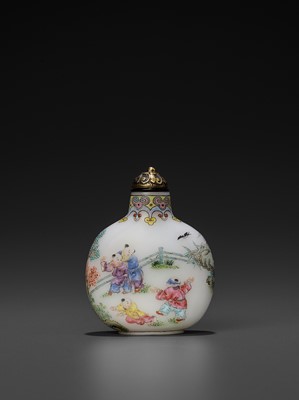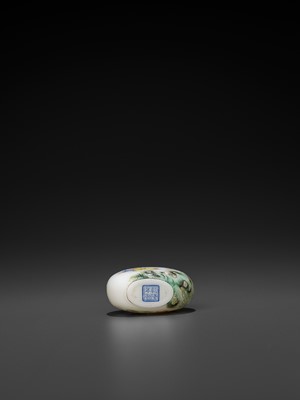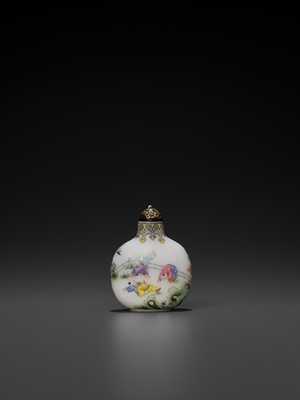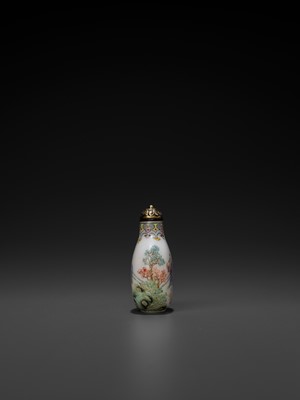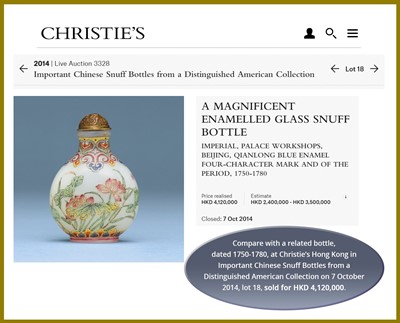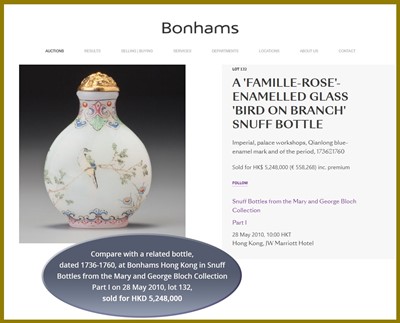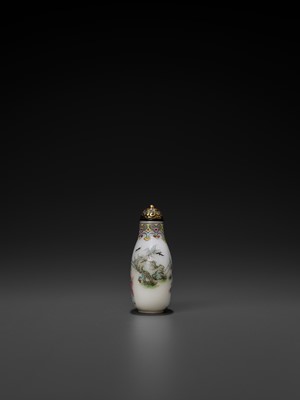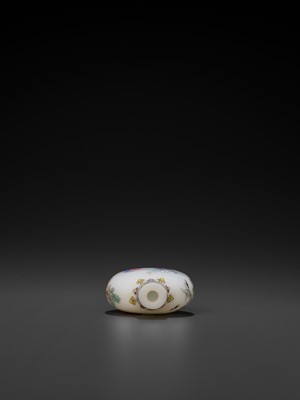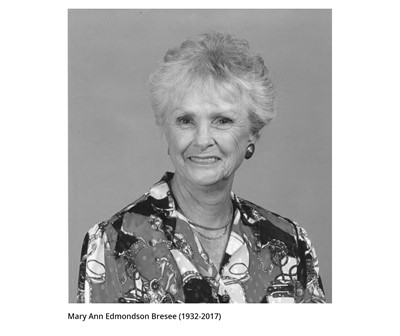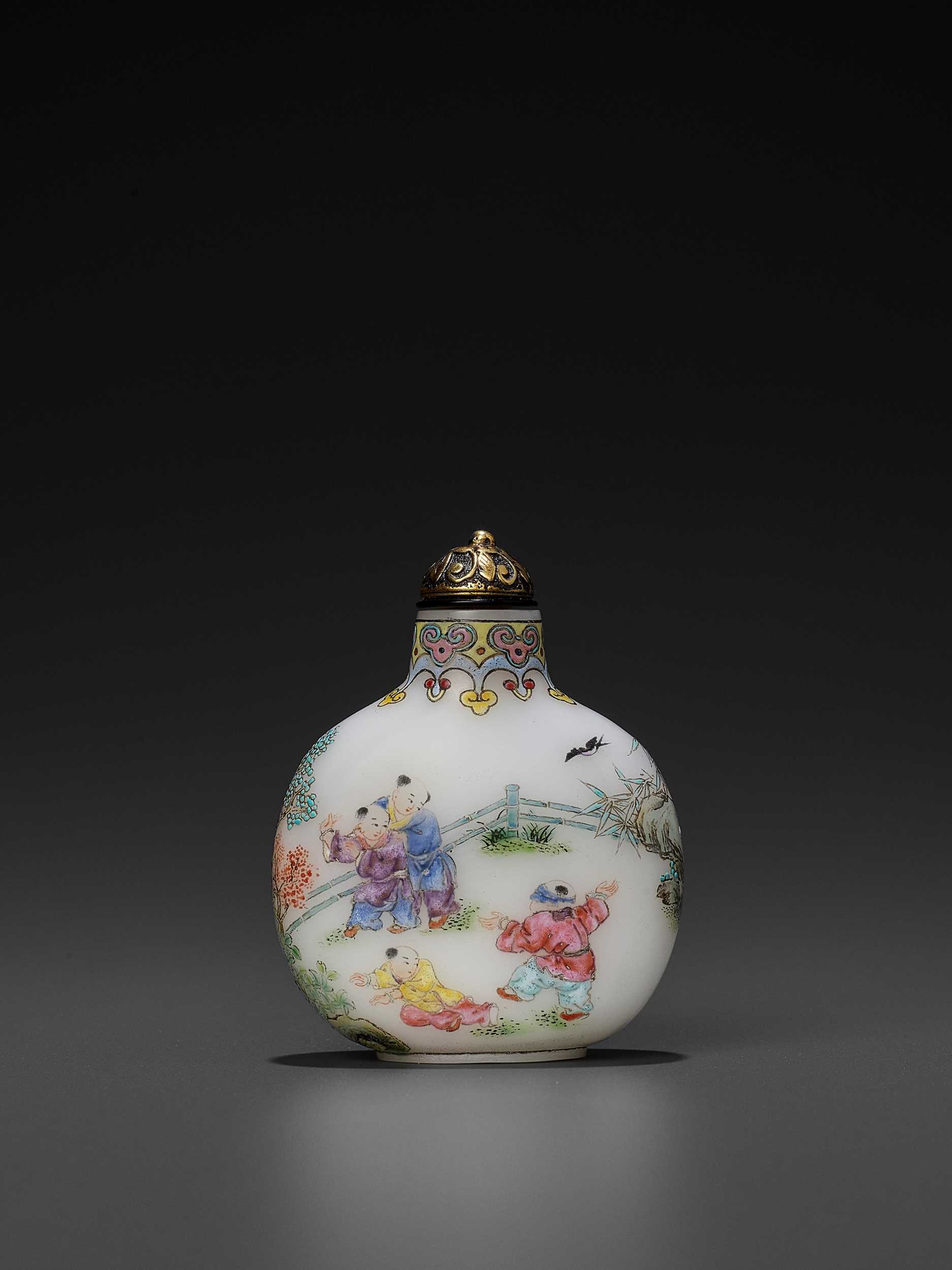5th Mar, 2021 10:00
TWO-DAY AUCTION - Fine Chinese Art / 中國藝術集珍 / Buddhism & Hinduism
390
AN IMPERIAL ENAMELED WHITE GLASS ‘BOYS’ SNUFF BOTTLE, QIANLONG MARK AND PERIOD
乾隆款與年代御制琺琅彩白料嬰戯圖鼻烟壺
Sold for €48,032
including Buyer's Premium
China, 1760-1780. Masterfully painted in soft enamels of imperial yellow, pink, blue, green, and turquoise on a translucent ivory-white ground with two scenes of boys at play below a ruyi-tassel border at the shoulder and neck, the recessed base with a blue-enameled four-character Qianlong nianzhi mark within a double square and of the period.
Provenance: From the collection of Mary Ann Edmondson Bresee (1932-2017), Georgia, USA, avid collector and former member of the International Chinese Snuff Bottle Society. Her grandfather was Walter T. Candler, son of Asa G. Candler, the founder of the Coca-Cola Company. Her bottles were exhibited both at the Cummer Museum of Art and Gardens and the Norton Museum of Art. Collector’s label ‘LH1’ to spoon.
Condition: Superb condition with some wear. Flaws in the glass include minuscule bubbles to the foot rim, partially polished off as a part of the manufacturing process. The crisp and fresh enamels with minor pitting and microscopic crackling in some areas.
Stopper: Gilt bronze with incised floral decorations, black collar, and neatly carved spoon
Weight: 40.7 g
Dimensions: Height including stopper 58 mm. Diameter neck 17 mm and mouth 6 mm
Four boys are playing a game of blind man’s buff to one side and three boys are performing gymnastics to the other, each in a fenced garden. In Chinese art the depiction of young boys at play is considered a sign of good fortune, representing the blessing of having many sons to carry on the family name. The shoulders of the bottle show birds in flight amid bamboo and craggy rockwork as well as blossoming prunus and wutong behind lingbi stones. The flattened globular body rises from a short broad oval foot to a tapering neck.
Of the two main Palace painted enamel arts (on glass and on metal), those on glass are the rarer. During the Qianlong reign enameled metal wares, including snuff bottles, ran into the thousands, whereas enameled glass wares were produced only in the low hundreds. A rough estimate of the total number of enameled glass snuff bottles produced during the period comes to about three hundred. This was mainly due to the greater difficulty of producing them successfully, the need for multiple firings to correctly mature different colors and layers of enamel, and the much higher failure rate during production. In the early phase of the art form, from the late Kangxi until the 1750s or early 1760s, technical control of the enamels was still marginal, and all known examples exhibit some degree of pitting or discoloration of the enamels. This continued to be a problem with some colors into the second half of the Qianlong reign. Although far from obtrusive, in the present bottle the blue enamel on some of the boys’ clothing in particular is pitted, but it is otherwise remarkably well fired.
The present type of translucent, milky-white glass was frequently used as an alternative to opaque white glass within the Palace workshops and is ideally suited to the equally translucent enamels. One of the key features of Palace enamels on glass is the softness, translucency, and delicacy of much of the palette, which allows for very subtle shading and gradations of color.
A distinctive feature of Qianlong painted enamels on glass is the relative thinness of the enamels and the painterly quality of the brushwork. Court artists, highly trained in the tradition of calligraphic brushwork that gave Chinese painting one of its most profound inner languages, were involved in drawing up the designs and sometimes in painting the enamels. Failing that, it was skilled enamellers trained in the same aesthetic and overseen by court artists who produced them from preparatory sketches. Artistically, these early, painterly enamels represent the apogee of glass enameling during the Qing dynasty, and the present bottle well exhibits this exceptional quality.
This design is purely Chinese in its conception, without any hint of the Western influence that appears, not unnaturally, in some wares with European subjects that rely to a greater extent on the use of color and chiaroscuro rather than line to create form. The red blossoms drawn without any in the present bottle do not by that quality reflect Western influence, but rather the 'bodiless' style made famous by Yun Shouping (1633–1690), whose works would have been well known to any court artist a mere half century after the painter's death. Here, the blossoms are balanced against the other elements of the design featuring the elegant black lines of the calligrapher's brush, with well-modulated, expressive strokes.
Expert’s note: The reign marks on earlier Qianlong enameled glass bottles are usually flush with the foot, in contrast to the raised blue enamel marks of the mid- to late reign as seen on the present bottle. Together with the masterful quality of the painting as well as the use of translucent glass and soft enamels, this allows us to further narrow the likely dating of this bottle to circa 1760-1770.
Literature comparison: Compare a bottle in the Palace Museum, Beijing, included in Snuff Bottles, The Complete Collection of Treasures of the Palace Museum, Hong Kong, 2003, no. 9. See also another bottle of this type from the J & J Collection, reproduced in Moss, Graham, Tsang, The Art of the Chinese Snuff Bottle. The J & J Collection, no. 187.
Auction result comparison: Compare with a related bottle, dated 1736-1760, at Bonhams Hong Kong in Snuff Bottles from the Mary and George Bloch Collection Part I on 28 May 2010, lot 132, sold for HKD 5,248,000, and another, dated 1750-1780, at Christie’s Hong Kong in Important Chinese Snuff Bottles from a Distinguished American Collection on 7 October 2014, lot 18, sold for HKD 4,120,000.
乾隆款與年代御制琺琅彩白料嬰戯圖鼻烟壺
中國,1760-1780年。在半透明的象牙白地上,使用黃色、粉紅色、藍色、綠色和青綠色等琺瑯彩精美描繪孩童玩耍場景。頸部飾如意紋。底足内凹凹進,藍色四字“乾隆年制”款。
來源:美國佐治亞州Mary Ann Edmondson Bresee(1932-2017)收藏。她曾是國際中國鼻煙壺協會的會員。 其祖父是Walter T. Candler,可口可樂公司創始人Asa 克Candler的兒子。 她的鼻烟壺在Cummer Museum of Art and Gardens博物館和Norton Museum of Art博物館均有展出。
圖片:Mary Ann Edmondson Bresee (1932-2017)
品相:狀況極佳,有些磨損。 玻璃中有些瑕疵,包括足部邊緣的微小氣泡,在製造過程部分打磨過。 琺瑯局部有輕微裂紋。
壺蓋:鎏金銅雕花卉紋,黑色蓋托,小壺匙
重量:40.7 克
尺寸:含蓋總高58 毫米,頸部直徑17 毫米,嘴部直徑6 毫米
專家注釋:乾隆時期早期款識通常與腳齊平,與本瓶中晚期所繪的藍色琺琅彩款相反。 再加上繪畫的精湛品質,以及使用半透明玻璃和洋彩,使我們可以進一步明確此鼻烟壺的年代,大約為1760-1770。
拍賣結果比較:一件相近1736-1760年間的鼻烟壺見香港邦翰斯Snuff Bottles from the Mary and George Bloch Collection Part I 拍場,2010年5月 28日 lot 132, 售價HKD 5,248,000, ;以及另一件1750-1780年間的鼻烟壺見香港佳士得 Important Chinese Snuff Bottles from a Distinguished American Collection 拍場,2014年10月7日 lot 18, 售價HKD 4,120,000.
China, 1760-1780. Masterfully painted in soft enamels of imperial yellow, pink, blue, green, and turquoise on a translucent ivory-white ground with two scenes of boys at play below a ruyi-tassel border at the shoulder and neck, the recessed base with a blue-enameled four-character Qianlong nianzhi mark within a double square and of the period.
Provenance: From the collection of Mary Ann Edmondson Bresee (1932-2017), Georgia, USA, avid collector and former member of the International Chinese Snuff Bottle Society. Her grandfather was Walter T. Candler, son of Asa G. Candler, the founder of the Coca-Cola Company. Her bottles were exhibited both at the Cummer Museum of Art and Gardens and the Norton Museum of Art. Collector’s label ‘LH1’ to spoon.
Condition: Superb condition with some wear. Flaws in the glass include minuscule bubbles to the foot rim, partially polished off as a part of the manufacturing process. The crisp and fresh enamels with minor pitting and microscopic crackling in some areas.
Stopper: Gilt bronze with incised floral decorations, black collar, and neatly carved spoon
Weight: 40.7 g
Dimensions: Height including stopper 58 mm. Diameter neck 17 mm and mouth 6 mm
Four boys are playing a game of blind man’s buff to one side and three boys are performing gymnastics to the other, each in a fenced garden. In Chinese art the depiction of young boys at play is considered a sign of good fortune, representing the blessing of having many sons to carry on the family name. The shoulders of the bottle show birds in flight amid bamboo and craggy rockwork as well as blossoming prunus and wutong behind lingbi stones. The flattened globular body rises from a short broad oval foot to a tapering neck.
Of the two main Palace painted enamel arts (on glass and on metal), those on glass are the rarer. During the Qianlong reign enameled metal wares, including snuff bottles, ran into the thousands, whereas enameled glass wares were produced only in the low hundreds. A rough estimate of the total number of enameled glass snuff bottles produced during the period comes to about three hundred. This was mainly due to the greater difficulty of producing them successfully, the need for multiple firings to correctly mature different colors and layers of enamel, and the much higher failure rate during production. In the early phase of the art form, from the late Kangxi until the 1750s or early 1760s, technical control of the enamels was still marginal, and all known examples exhibit some degree of pitting or discoloration of the enamels. This continued to be a problem with some colors into the second half of the Qianlong reign. Although far from obtrusive, in the present bottle the blue enamel on some of the boys’ clothing in particular is pitted, but it is otherwise remarkably well fired.
The present type of translucent, milky-white glass was frequently used as an alternative to opaque white glass within the Palace workshops and is ideally suited to the equally translucent enamels. One of the key features of Palace enamels on glass is the softness, translucency, and delicacy of much of the palette, which allows for very subtle shading and gradations of color.
A distinctive feature of Qianlong painted enamels on glass is the relative thinness of the enamels and the painterly quality of the brushwork. Court artists, highly trained in the tradition of calligraphic brushwork that gave Chinese painting one of its most profound inner languages, were involved in drawing up the designs and sometimes in painting the enamels. Failing that, it was skilled enamellers trained in the same aesthetic and overseen by court artists who produced them from preparatory sketches. Artistically, these early, painterly enamels represent the apogee of glass enameling during the Qing dynasty, and the present bottle well exhibits this exceptional quality.
This design is purely Chinese in its conception, without any hint of the Western influence that appears, not unnaturally, in some wares with European subjects that rely to a greater extent on the use of color and chiaroscuro rather than line to create form. The red blossoms drawn without any in the present bottle do not by that quality reflect Western influence, but rather the 'bodiless' style made famous by Yun Shouping (1633–1690), whose works would have been well known to any court artist a mere half century after the painter's death. Here, the blossoms are balanced against the other elements of the design featuring the elegant black lines of the calligrapher's brush, with well-modulated, expressive strokes.
Expert’s note: The reign marks on earlier Qianlong enameled glass bottles are usually flush with the foot, in contrast to the raised blue enamel marks of the mid- to late reign as seen on the present bottle. Together with the masterful quality of the painting as well as the use of translucent glass and soft enamels, this allows us to further narrow the likely dating of this bottle to circa 1760-1770.
Literature comparison: Compare a bottle in the Palace Museum, Beijing, included in Snuff Bottles, The Complete Collection of Treasures of the Palace Museum, Hong Kong, 2003, no. 9. See also another bottle of this type from the J & J Collection, reproduced in Moss, Graham, Tsang, The Art of the Chinese Snuff Bottle. The J & J Collection, no. 187.
Auction result comparison: Compare with a related bottle, dated 1736-1760, at Bonhams Hong Kong in Snuff Bottles from the Mary and George Bloch Collection Part I on 28 May 2010, lot 132, sold for HKD 5,248,000, and another, dated 1750-1780, at Christie’s Hong Kong in Important Chinese Snuff Bottles from a Distinguished American Collection on 7 October 2014, lot 18, sold for HKD 4,120,000.
乾隆款與年代御制琺琅彩白料嬰戯圖鼻烟壺
中國,1760-1780年。在半透明的象牙白地上,使用黃色、粉紅色、藍色、綠色和青綠色等琺瑯彩精美描繪孩童玩耍場景。頸部飾如意紋。底足内凹凹進,藍色四字“乾隆年制”款。
來源:美國佐治亞州Mary Ann Edmondson Bresee(1932-2017)收藏。她曾是國際中國鼻煙壺協會的會員。 其祖父是Walter T. Candler,可口可樂公司創始人Asa 克Candler的兒子。 她的鼻烟壺在Cummer Museum of Art and Gardens博物館和Norton Museum of Art博物館均有展出。
圖片:Mary Ann Edmondson Bresee (1932-2017)
品相:狀況極佳,有些磨損。 玻璃中有些瑕疵,包括足部邊緣的微小氣泡,在製造過程部分打磨過。 琺瑯局部有輕微裂紋。
壺蓋:鎏金銅雕花卉紋,黑色蓋托,小壺匙
重量:40.7 克
尺寸:含蓋總高58 毫米,頸部直徑17 毫米,嘴部直徑6 毫米
專家注釋:乾隆時期早期款識通常與腳齊平,與本瓶中晚期所繪的藍色琺琅彩款相反。 再加上繪畫的精湛品質,以及使用半透明玻璃和洋彩,使我們可以進一步明確此鼻烟壺的年代,大約為1760-1770。
拍賣結果比較:一件相近1736-1760年間的鼻烟壺見香港邦翰斯Snuff Bottles from the Mary and George Bloch Collection Part I 拍場,2010年5月 28日 lot 132, 售價HKD 5,248,000, ;以及另一件1750-1780年間的鼻烟壺見香港佳士得 Important Chinese Snuff Bottles from a Distinguished American Collection 拍場,2014年10月7日 lot 18, 售價HKD 4,120,000.
Zacke Live Online Bidding
Our online bidding platform makes it easier than ever to bid in our auctions! When you bid through our website, you can take advantage of our premium buyer's terms without incurring any additional online bidding surcharges.
To bid live online, you'll need to create an online account. Once your account is created and your identity is verified, you can register to bid in an auction up to 12 hours before the auction begins.
Intended Spend and Bid Limits
When you register to bid in an online auction, you will need to share your intended maximum spending budget for the auction. We will then review your intended spend and set a bid limit for you. Once you have pre-registered for a live online auction, you can see your intended spend and bid limit by going to 'Account Settings' and clicking on 'Live Bidding Registrations'.
Your bid limit will be the maximum amount you can bid during the auction. Your bid limit is for the hammer price and is not affected by the buyer’s premium and VAT. For example, if you have a bid limit of €1,000 and place two winning bids for €300 and €200, then you will only be able to bid €500 for the rest of the auction. If you try to place a bid that is higher than €500, you will not be able to do so.
Online Absentee and Telephone Bids
You can now leave absentee and telephone bids on our website!
Absentee Bidding
Once you've created an account and your identity is verified, you can leave your absentee bid directly on the lot page. We will contact you when your bids have been confirmed.
Telephone Bidding
Once you've created an account and your identity is verified, you can leave telephone bids online. We will contact you when your bids have been confirmed.
Classic Absentee and Telephone Bidding Form
You can still submit absentee and telephone bids by email or fax if you prefer. Simply fill out the Absentee Bidding/Telephone bidding form and return it to us by email at office@zacke.at or by fax at +43 (1) 532 04 52 20. You can download the PDF from our Upcoming Auctions page.
How-To Guides
How to Create Your Personal Zacke Account
How to Register to Bid on Zacke Live
How to Leave Absentee Bids Online
How to Leave Telephone Bids Online
中文版本的操作指南
创建新账号
注册Zacke Live在线直播竞拍(免平台费)
缺席投标和电话投标
Third-Party Bidding
We partner with best-in-class third-party partners to make it easy for you to bid online in the channel of your choice. Please note that if you bid with one of our third-party online partners, then there will be a live bidding surcharge on top of your final purchase price. You can find all of our fees here. Here's a full list of our third-party partners:
- 51 Bid Live
- EpaiLive
- ArtFoxLive
- Invaluable
- LiveAuctioneers
- the-saleroom
- lot-tissimo
- Drouot
Please note that we place different auctions on different platforms. For example, in general, we only place Chinese art auctions on 51 Bid Live.
Bidding in Person
You must register to bid in person and will be assigned a paddle at the auction. Please contact us at office@zacke.at or +43 (1) 532 04 52 for the latest local health and safety guidelines.
